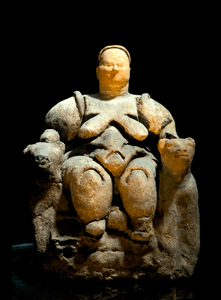
Çatalhöyük, "Fork Mound" (partial excavation model)


Anatolic Culture (Asia Minor, Republic of Turkey, occupied from approximately 7500 B.C.E. to 5700 B.C.E., and flourished around 7000 B.C.E. It is the largest and best-preserved Neolithic site found to date. In July 2012, it was inscribed as a UNESCO site. Established before the invention of crop agriculture by hunter-gathers, Çatalhöyük was one of the first proto-urban communities in the world. With a population of between 3500 to 8000. and covering an area of 13 hectares (32 acres), there were no streets, and movement within the conglomeration was on the rooftops, with entry to rooms below from openings in the roofs., much like the Pueblo architecture of the American Southwest. Rooms inside had raised platforms rather than full height interior partition walls and the outer walls were decorated inside wtih paintings and skulls. This has led to the interpretation that many of these rooms were shrines, rather thant ordinary houses. Archaeologists have found ruin deposits for the buildings 20 vertical meters deep (65 feet). Kept animals were in pens and trash middens were adjacent to the dwellings, which would have posed serioius health problems. The community reached its resource limits as firewood became more and more distant from the core.
Elevation is 2008 meters (6590 feet) above sea level
Material: Mud brick walls, tree log roof rafters, mud/clay roof on fiber matting.
Data for CG model:
1. http://www.literature-middle-ages.com/architecturesocieties_/26572-catal-hoyuk.html
2. Topography from Google Earth and http://old.wikimapia.org
3. Pinterest.com: scaled plans
4. Larsen, Clark Spencer, et al, 2019; Bioarchaeology of Neolithic Çatalhöyük reveals fundamental transitions in health, mobility, and lifestyle in early farmers; Proceedings of the National Academy of Sciences of the USA, June 17, 2019
https://doi.org/10.1073/pnas.1904345116









